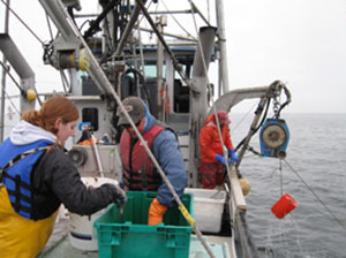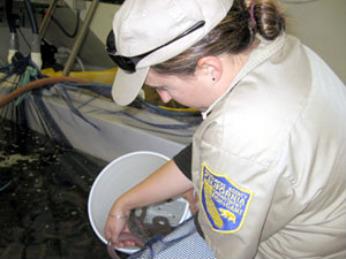Hagfish
 Staff at work during a hagfish research vessel.
Staff at work during a hagfish research vessel.
 Biologist sampling commercial hagfish using the average number of hagfish per pound method.
Biologist sampling commercial hagfish using the average number of hagfish per pound method.
Pacific hagfish, like other hagfish, represent an ancient form of life that has remained virtually unchanged since the Paleozoic era 450 million years ago. It is a cartilaginous fish that lacks scales, paired fins, a stomach, and true jaws. It has rudimentary eyes (eye spots) that are only able to detect light, and relies on its keen sense of smell and touch to get around (using a single nostril and barbels, respectively). The hagfish's jawless mouth contains two parallel rows of pointed keratinous teeth, which are secured to rasping dental plates.
The hagfish's body is cylindrical and elongated; it moves in a snake-like motion using its paddle-like tail. It has a row of "slime" glands on both sides of its body. When agitated, these glands produce a protein-based mucous that when combined with water makes a thick, viscous jelly-like slime. This slime serves as a defense mechanism that can be sloughed off by tying its body into a knot, and also by "sneezing" to clear the slime from its sinus cavities. This knot-tying motion is also used to escape predators, and during feeding.
Considered a scavenger, the hagfish feeds mostly on dead and dying fish and marine mammals, thereby playing an important role in the ecosystem. Using its keen sense of smell, the hagfish will identify its food source and either burrow into its prey by making a hole with its rasping teeth, or entering through an existing opening to consume it from the inside out, usually only leaving skin and bones when it is done. Due to its slow metabolism, the hagfish may survive for up to seven months without eating. When other food sources are not available, it subsists on worms and other bottom fauna. The hagfish is preyed upon by some marine mammals and large invertebrates, but most stay away due to the risk of slime suffocation.
Species Identification
Kingdom: Animalia
Phylum: Chordata
Class: Myxini
Order: Myxiniformes
Family: Myxinidae
Genus: Eptatretus
Species: stoutii (Pacific hagfish)
 Pacific Hagfish (Esptatretus stoutii) specimen. Ruler is in centimeters. Photo courtesy of Andrew Clark.
Pacific Hagfish (Esptatretus stoutii) specimen. Ruler is in centimeters. Photo courtesy of Andrew Clark.
The Pacific hagfish (Eptatretus stoutii) is eel-like, with 10 to 14 pores along its elongated body. It usually ranges in color from tan to brown or grey on the top and lighter on the bottom. It can be found at depths ranging from 60 to 3000 feet on mud substrate. Sampling of California commercial fishery landings has shown that the average Pacific hagfish measures between 12 and 18 inches in length.
A mature Pacific hagfish female will produce between 20-30 eggs per reproductive cycle. There is no known reproductive season or cycle length for hagfish.
Another hagfish species that may occur in California is the black hagfish (Eptatretus deani); it is found in deeper water, is darker in coloration (purplish black), and has a shorter head in proportion to the body.
Hagfish Studies
The Northern and Central California Finfish Research and Management Project has implemented a fishery-dependent sampling program to monitor the hagfish fishery. Collaborating with Tim Maricich on the F/V Donna Kathleen and Collaborative Fisheries Research West, project biologists gather data on the average size of hagfish landed at local ports. Because it is difficult to measure the length of a live hagfish, biologists record the average number of hagfish per pound from the sampled catch to document changes in the average size of harvested fish. Monthly port landing totals and changes within the fishery are also documented.
The first-ever collaborative hagfish survey was completed by the Project in Monterey Bay on March 25-28, 2013. Using 96 standard bucket traps, of which there were 24 buckets for each hole diameter (0.375, 0.50, 0.5625, 0.625 inches), Project staff counted 7,595 hagfish for a total weight of 1,811 lb over the course of 3 full survey days. An additional 1,441 hagfish were counted on the first “prospecting” day. During the prospecting day, soak times were only 2-4 hr, while on full survey days soak times were approximately 24 hr. Based on field observations and average counts per pound per bucket hole diameter, the hypothesis that hole diameter influences average size of hagfish caught was proven correct.